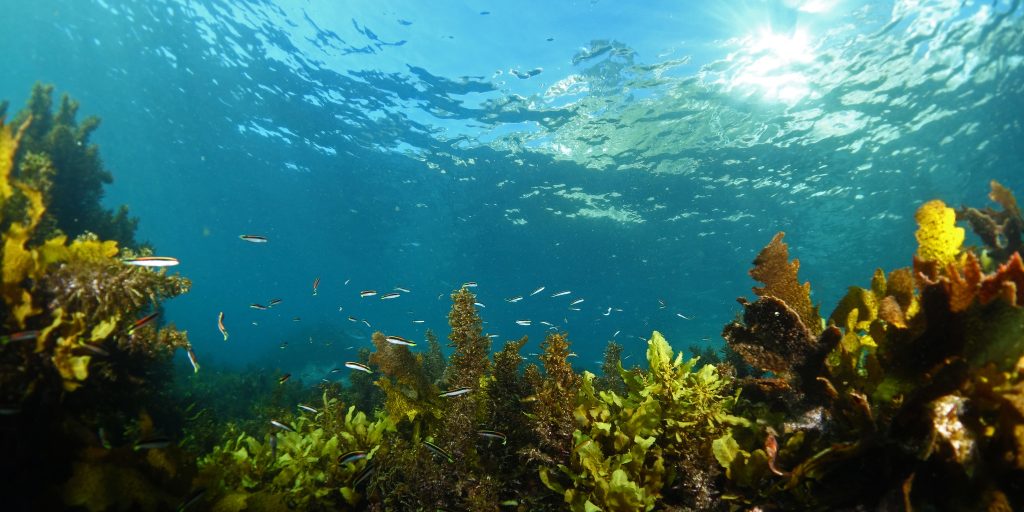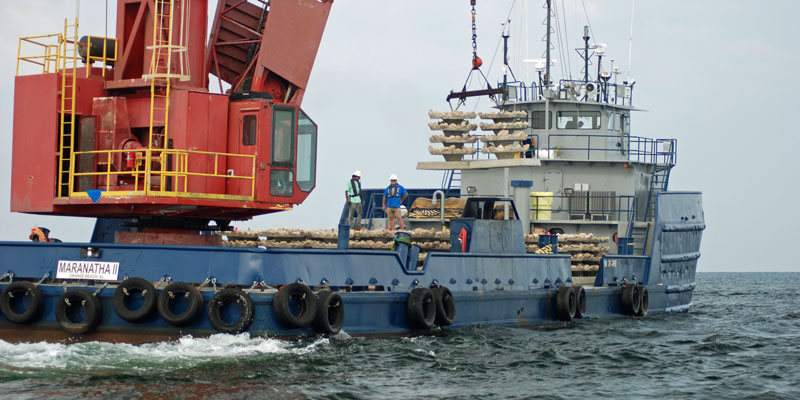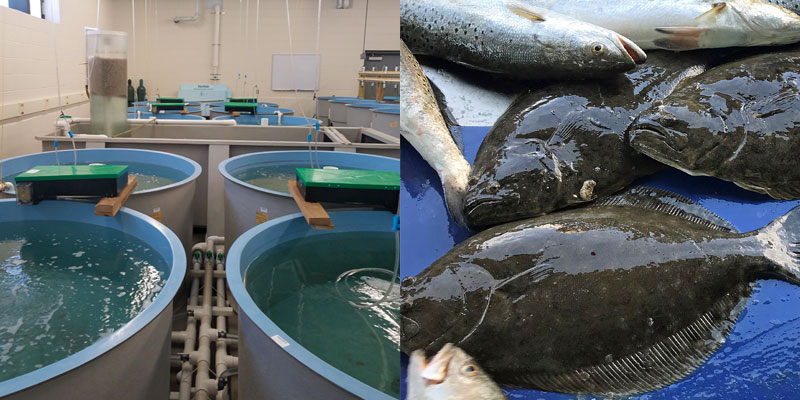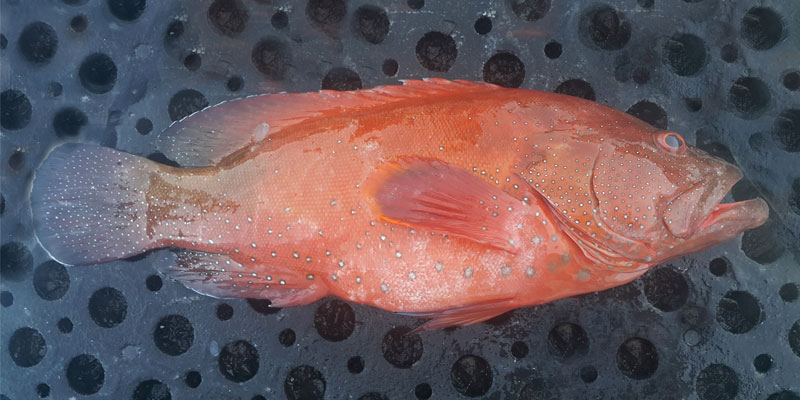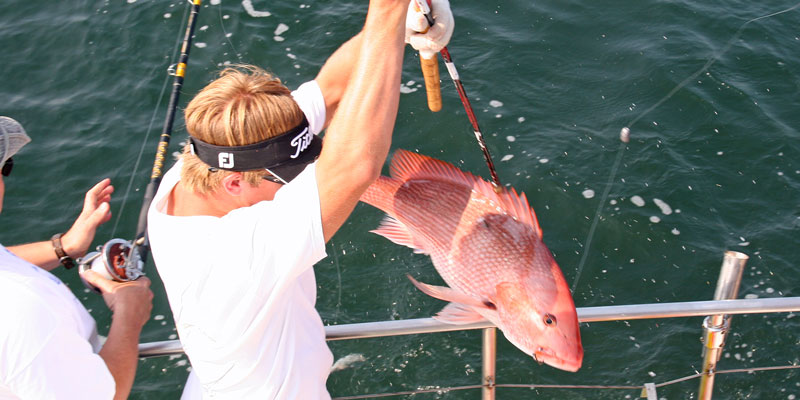Navy Cove oyster farm in Fort Morgan is one of the pioneers of aquaculture along the Gulf of Mexico. Chuck Wilson founded the farm in 2011, when the idea of growing single oysters in off-bottom cages or baskets was still a new concept in the area. As mouths around the South – and the country – started tipping up half-shells of Alabama-farmed oysters and slurping them down, the product’s popularity increased, and the number of devoted fans grew alongside the state’s oyster-farming industry.
In March 2020, Navy Cove was getting ready to harvest a bumper crop of bivalves and deliver them to restaurants that would serve them to hungry beach crowds, and they expected to do the same all summer long. The pandemic put the brakes on it all.
“We had a lot of oysters on the farm that were about to be market size in March and early April, right when things started shutting down,” Wilson said. Business dropped precipitously and quickly. “We expected to sell 15,000 to 20,000 oysters per week from spring through August. We sold a third of that.”
Turbulent tides
Troubled times had come to Navy Cove, but Wilson wasn’t alone. The phone in the office of LaDon Swann, director of the Mississippi-Alabama Sea Grant Consortium, started ringing in April 2020, with oyster farmers on the line asking for advice and assistance. The issue was surplus oysters, which was a two-pronged problem.
First, with restaurants shut down or at low capacity, demand for oysters was low and farmers were losing sales, so cash flow and bottom lines were being crippled. Second, the oysters not being sold were tying up valuable space on their farms. And while they sat in the water, they kept growing, eventually becoming too big for the half-shell raw market, thus losing value. Plus, the uncertain future made time-dependent decisions – like, should we buy more seed (baby oysters) and can we even afford to? – more fraught with risk than usual.
Swann listened and knew his organization and others that worked with and served the industry had to find a way to help. “We took what the farmers were saying, combined that with our knowledge of the oyster farming industry and came up with a plan,” he said.
Then they got funding. The National Sea Grant office reallocated some of its aquaculture dollars, as did the Mississippi-Alabama Sea Grant Consortium. The Alabama Power Foundation also provided support. Swann expanded the team, pulling in Bill Walton and Rusty Grice of the Auburn University Shellfish Lab as well as the Alabama Marine Resources Division and the Mississippi Division of Marine Resources. Together, they created Concerned Oystermen Restoring Estuaries (CORE) and implemented an innovative strategy to provide fast and much-needed aid to farmers while delivering proven environmental benefits, as well as a bonus: the chance to conduct research that could pay additional environmental and industry dividends.
CORE uses farm-grown oysters to help restore Gulf estuaries from Alabama NewsCenter on Vimeo.
Win-win-win
At the shellfish lab on Dauphin Island, Walton gets amped up talking about the program. There’s a stiff wind blowing in off the bay as the associate professor, extension specialist and all-around-oyster enthusiast explained, “We’re helping farmers; we’re helping the environment now; and we’re exploring ways to help the wild oyster populations even more in the future. There are so many positives.”
CORE’s solution is straightforward. Buy the farmers’ extra oysters, the ones they couldn’t sell. That gives them some income and frees up farm space. Next, load these big, healthy oysters in a boat, motor over to existing wild oyster reefs identified by Marine Resources and dump them into the water, where they settle below on the reefs mostly in Mississippi Sound. So far, CORE has deployed about 189,000 oysters purchased from 11 farms, eight in Alabama and three in Mississippi.
“More oysters in the water are always a good thing,” Walton said. First, they filter the water, taking out extra phytoplankton, which improves water clarity. Clear water lets more sunlight through, resulting in a healthier environment on the bottom, which can prompt sea grasses to grow. Live oyster reefs provide homes for other animals, and the bigger the reef, the bigger that habitat.
“There are lots of other sea critters that like to live amongst clusters of oysters,” Walton said. “What we did through this program was enlist oyster farmers to help us augment what’s going on in nature.”
Most oysters purchased during the pandemic for restoration were triploid and won’t spawn to make more new oysters, since most farmers are now raising triploid or “sexless” oysters. They do this because oysters that don’t put any effort into reproduction devote more energy into growing plump and tasty. Walton said it is no problem at all.
“So why would we put nonreproductive oysters out as restoration? There’s a really good reason,” he said. “Once wild oysters spawn, the juvenile oysters are just swimming around, looking for a place to set and call home.” The older oysters, including sexless triploids, on the reefs release a chemical cue, and when the new oysters sense it, they head over and grab a spot.
“So, we’re taking these big triploids and putting them down there, and they’re not going to provide the next generation. But, when they put out the ‘welcome home’ sign to all those microscopic larvae that are in the water, they are recruiting that next generation and helping them settle on the reef. And the more oysters there are, that sign is like a giant, flashing neon signal.” And then, that generation spawns, and the cycle expands and continues.
Gaining more insight into this process is one aspect of the Shellfish Lab’s role in CORE. “We’ll be watching to see these oysters’ survival and growth once they’re on the reefs,” Walton said. The obvious pluses – filtering water, providing habitat – are being documented, but the data will also help show how harnessing live oysters’ ability to recruit could be a key piece of tomorrow’s reef restoration efforts.
In the past, there’s been major investment in putting out structures and oyster shells to build and refurbish wild reefs. But Walton is not so sure the work should stop there.
“For a while there was definitely the mindset that if you build it, they will come,” he said. “But I’ve seen a lot of places where shell or artificial reefs have been put out, and we don’t see many oysters there. That’s why I think what we’ve done here could help. Does making an area, a reef, really attractive to the next generation make sense as an intentional restoration technique? That’s the question I hope we can answer through this.”
While this program will eventually end, when Walton and his team complete their research they can make a case for what might advance oyster reef restoration: oyster farms raising oysters specifically for that purpose. “Right now, we think of an oyster farm, we think of them as raising oysters for food. But I can see what I would call an expanded restoration market,” Walton said.
Swann agreed with Walton on the many positives of the program. “We’ve helped the farmers with cash flow, so they can stay in business, buy more seed and keep moving forward,” he said. And, like Walton, he’s excited about the potential of expansion. “I really want to see this open the door to get farmers more involved in reef restoration. That would be great.”
Wilson is ready to go. “I think CORE has worked out a model for what oyster farmers could do in the future to help restore reefs. I think a lot of farms have some available capacity that they could dedicate to growing oysters strictly for restoration.” He also praised the team that collaborated through CORE.
“I think all involved saw this opportunity to help farmers and the environment in one swoop and worked together to find the funds and make it happen,” he said. “It’s been really wonderful to watch.”
This story is part of a series about nonprofits aided by the Alabama Power Foundation, based on the foundation’s 2020 Annual Report, “At the Point of Change.” Read stories about The King’s Canvas and Red Door Kitchen.
(Courtesy of Alabama NewsCenter)






